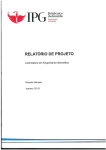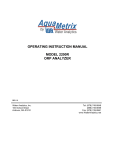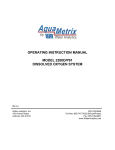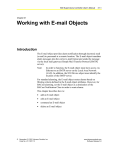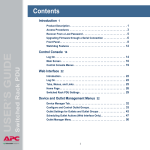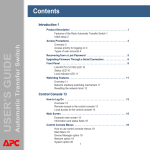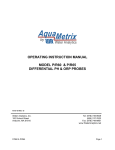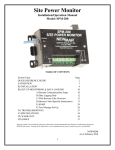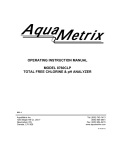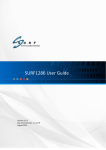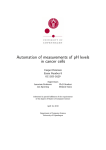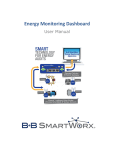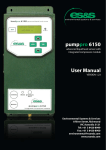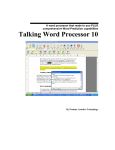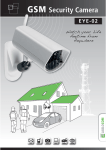Download AquaMetrix 2300 - Lesman Instrument Company
Transcript
AquaMetrix by Water Analytics AquaMetrix 2300 Controller Installation & Operation Manual V1.3 ©Water Analytics 2014 All rights reserved. Last revised: February 11, 2014 For Your Safety Please read this entire manual before unpacking, setting up or operating this equipment. Pay attention to all danger and caution statements. Failure to do so could result in serious injury to the operator or damage to the equipment. Make sure that the protection provided by this equipment is not impaired, do not use or install this equipment in any manner other than that specified in this manual. If this equipment is used in a manner not specified by the manufacturer, the protection provided by the equipment may be impaired. Statement of Limited Warranty WATER ANALYTICS warrants that this product is free from defects in workmanship and material for a period of 24 months for electronics from the date of delivery from the factory or authorized distributor under normal use. WATER ANALYTICS’s liability under this warranty shall be limited to replacement or repair of any defective equipment or part which, having been returned to WATER ANALYTICS, transportation charges prepaid, has been inspected and determined by WATER ANALYTICS to be defective. Copyright 2014 Water Analytics, Inc. All rights reserved. Water Analytics, Inc 100 School St. Andover, MA 0810 Information: [email protected] Support issues can be emailed to [email protected]. Warning: The AC power input presents an electrical hazard. N116-133 AquaMetrix 2300 Installation and Operation Manual Page 2 AquaMetrix by Water Analytics 2300 Multi-Parameter Controller Table of Contents AquaMetrix 2300 Controller Installation & Operation Manual ............................... 1 1. Overview ............................................................................................................................. 5 1.1. Introduction .......................................................................................................................... 5 1.2. Specifications ........................................................................................................................ 5 1.3. Front Panel Display ............................................................................................................... 6 1.4. Front Panel Menu ................................................................................................................. 7 1.5. Ethernet Connection to a network switch or router ............................................................ 8 1.6. Probe Status Screen .............................................................................................................. 8 1.7. The Web Menu ................................................................................................................... 10 2. Installation and Housekeeping ................................................................................ 11 Password Change ................................................................................................................ 12 Time Setup .......................................................................................................................... 12 E-‐Mail Setup ........................................................................................................................ 12 Configure Data Logging ....................................................................................................... 12 2.1. 2.2. 2.3. 2.4. 3. Connecting and Configuring Probes ....................................................................... 13 3.1. Configuring Analog Sensors ................................................................................................ 13 3.2. Connecting Pulse Rate Output Sensors .............................................................................. 13 3.3. Probe Configuration Setup ................................................................................................. 14 3.4. The Probe Configuration Wizard ........................................................................................ 15 3.5. Two-‐Point Scaling or Calibration ......................................................................................... 17 3.6. Non-‐Linear Scaling .............................................................................................................. 18 3.7. Scale Factor ......................................................................................................................... 20 3.8. K-‐Factor Scaling ................................................................................................................... 20 The K-Factor option allows for a constant factor to be used to scale a frequency input into units of flow, ie volume per unit time. The K Factor is provided by the flow meter manufacturer in units of pulses per volume, where volume is typically gallons or liters. In order to display and record the proper units for the flow, the user must twice enter the volume units and the time units. The first time is on the same wizard page as the K Factor, where the choices are limited to gallons and liters for the volume, and seconds, minutes, hours, and days for the time. These entries are used by the 2300 to calculate the proper readings. The second time is on the next wizard page for the units to display. If the desired units are not on the pull down menu, choose Enter new units and type in what you want to see. Try to keep the total number of characters to less than 6. .......................................................................................................... 20 4. Configuring Virtual Probes ........................................................................................ 20 4.1. Configuring a Totalizer Sensor ............................................................................................ 20 4.2. Configuring Differential Sensors ......................................................................................... 21 4.3. Configuring a Flow Sensor for Batch Control ...................................................................... 21 5. Configuring Alarms, Relays, and Notifications .................................................... 22 5.1. Types of Monitors ............................................................................................................... 22 N116-133 AquaMetrix 2300 Installation and Operation Manual Page 3 5.2. Configuring for Email Notification ...................................................................................... 26 6. Logs and Data Logging ................................................................................................. 27 6.1. Data Logging Configuration Wizard .................................................................................... 28 6.2. Alarm Logs .......................................................................................................................... 28 7. User Maintenance and Passwords .......................................................................... 29 7.1. Web Passwords ................................................................................................................... 29 7.2. Front Panel Passcodes and LCD Configuration ................................................................... 29 8. Operating the 2300 without a Network ................................................................ 30 8.1. Front Panel Calibration ....................................................................................................... 30 8.2. Front Panel Relay Set Points ............................................................................................... 32 8.3. Front Panel Save and Restore Configuration ...................................................................... 33 9. Configuring the 2300 for a Network ....................................................................... 33 Dynamic IP Setup ................................................................................................................ 33 Viewing the 2300 on a Wide Area Network ........................................................................ 33 Dedicated wireless connection via a Smart Phone or Tablet .............................................. 34 Static IP Address Setup and Wired Connection .................................................................. 35 9.1. 9.2. 9.3. 9.4. 10. Network Setup ............................................................................................................. 36 Ethernet Setup .................................................................................................................. 36 Web Server and TFTP Server Setups ................................................................................. 37 Email Setup ....................................................................................................................... 37 Email Keyword List ............................................................................................................ 38 Email To Addresses ........................................................................................................... 39 Diagnosing Email Problems .............................................................................................. 39 10.1. 10.2. 10.3. 10.4. 10.5. 10.6. 11. Configuring the System ............................................................................................. 39 11.1. System Name and Time .................................................................................................... 39 11.2. Browser Configuration and Logging Out .......................................................................... 40 11.3. LCD Configuration ............................................................................................................. 40 11.4. Error Handling ................................................................................................................... 40 11.5. Unit List ............................................................................................................................. 41 12. Advanced Setup ........................................................................................................... 41 13. Available I/O Card Types ......................................................................................... 42 3-‐channel Digital Input + 4-‐channel Digital Relay Output card ......................................... 42 6-‐channel Digital Relay Output card ................................................................................. 43 7-‐channel Digital Input card ............................................................................................. 43 4-‐channel Analog Output card .......................................................................................... 43 13.1. 13.2. 13.3. 13.4. 14. Rebuilding a Corrupted Internal SD Card ........................................................... 44 15. Panel Mounting Dimensions ................................................................................... 45 N116-133 AquaMetrix 2300 Installation and Operation Manual Page 4 1. Overview 1.1. Introduction The AquaMetrix 2300 Controller is a multi-input controller that is web-enabled such that it can be setup in minutes from any web browser. It contains a number of Set-up Wizards to aid the user in entering information, much of which is not reproduced in this manual. The Wizards and most other screens in the 2300 Controller are organized by a dialogue followed by a summary page with “Submit” and “Cancel” at the bottom. The user may familiarize himself/herself with the 2300 by going through most menu functions and just hitting “Cancel” and not “Submit”. The standard configuration inputs up four 4-20mA analog sensors and three digital/frequency inputs for flow monitoring. Outputs include four relays and unlimited email/text notifications. The 2300 Controller provides remote viewing capability and configuring with password from any connected web browser. It also provides data logging with downloading or emailing of log files in CSV format. There is also one available slot for an optional card, which can expand digital inputs or relays outputs, or add analog outputs. 1.2. Specifications Table 1 - Specifications Inputs Analog Four 4-20 mA powered or unpowered current loops Pule Rate Two optically isolated inputs suitable for flow sensors, up to 24 VDC or 120 VAC Counter One accumulator for tracking equipment on time Contacts Four contact sensing inputs for alarm acknowledgement or remote resets. Outputs Relays Four 120V/240 V @ 10A/5A expandable to eight* Alerts Emails and/or texts for alarms, relay actions, errors, or reminders Web Remote viewing with a browser on a computer, tablet, or smart phone. Remote programming from any of these. Data logging Logging of CSV files directly to micro SD card Digital Outputs Modbus TCP over Ethernet connection Analog Outputs Optional: Four non-isolated 4-20 mA outputs proportional to any reading.* Control Web or LAN Viewing with a browser on a computer, tablet, or smart phone. Setup and control from any of these. Multi-user password protected. Front Panel Status, Probe enable/disable/calibrate, System Configuration Ratings N116-133 AquaMetrix 2300 Installation and Operation Manual Page 5 Current 0.3 A Temperature 0 to 70 0C Protection NEMA 4X, 1/4 DIN panel mount or wall mount with optional hardware Physical Mounting 1/4 DIN panel mount or wall mount with optional hardware Dimensions Front cover: 6.5” wide x 5.5” tall; rear enclosure: 3.5” wide x 3.5” tall x 4.5” deep Power 120 or 220 VAC, 60 or 50 Hz, auto-recognized. (Cable not included) Weight 2 lbs. *One expansion card slot is available 1.3. Front Panel Display The 2300 front panel display shows a series of RUN screens and MENU screens. It is meant to be the secondary user interface, and has only select capabilities such as viewing status, calibrating probes, setting relay set that have already been defined by the primary, network interface. There are eight navigation buttons below the screen, including four arrows. The functions of the others are: • RUN brings up the quad screen from anywhere • MENU brings up the front panel menu • BACK returns the user to the previous screen, and • ENTER selects the highlighted choice. The Run screens include a summary screen showing the status and values of 4 probes at one time. If more than 4 probes are enabled in the controller, the Down and Up arrows may be used to see more than the first 4 probes. Detailed status screens are shown using the Right arrow button, which brings up the first probe status with monitor and relay settings. The Down and Up arrows cycle through screens of individual probes. Pressing the Left arrow button brings back the summary Run screen. When a probe activates an alarm the front panel display automatically switches to a flashing detailed status screen. To restore the screen to the full display simply click on (or, for the real controller, press) the Run button. Each quadrant in the Run screen shows a probe label, current value with units, trend arrows for the reading, and a status light for the controller outputs. The status light is green for normal operation, yellow for an activated relay, and red for an activated alarm. The Right Arrow brings up a detailed screen, shown on the right side of Figure 1. This screen lists the monitor outputs for this probe, including the monitor description and set point value, along with the Last Calibration date. The monitors are color coded, with green for normal operation, red for alarm condition, and yellow for an activated relay. N116-133 AquaMetrix 2300 Installation and Operation Manual Page 6 Pressing the Down arrow will cycle through all of the individual probe screens. Pressing the Enter button will bring up a Meter Action screen, allowing the user to acknowledge an alarm, if active, or setting relay trip points. Run button will bring up the Run screen once again. AquaMetrix 2300 Tank ORP Multi-Parameter Controller Tank pH 386 7.35 pH Tank D.O. 3.92 mV Tank Level ppm 88 cm Run Back Menu Enter Figure 1 - The Run display on the left reports 4 process values at a time. If there are more than 4 pressing the down button reveals these. The identical image appears on the web browser. The Detail display on the right shows the detailed status of the Tank pH condition. 1.4. Front Panel Menu The front panel menu is limited to a select group of functions. The outline of this menu structure is below, with descriptions. View System Info Disable/Calibrate Probe Backup/Restore Reboot System Prepare for Power Down View Raw Analog View Raw Precision Network Setup Network Type Web Server Port Commit and Restart Main Menu Unit name, IP address, software version, and system status information Manually disable, enable, or calibrate defined probes Save or restore the unit configuration and setup to a removable SD card Powers down and restarts controller After a confirmation dialog is confirmed, all probes are disabled, all logs are closed, and the system is put in a state where it is safe to remove power from the controller. Advanced Menu Not used Not used Change the network between Dynamic (DHCP) and Static IP DHCP or Static IP; allows manual entry of static IP data Allows entry of port number Confirm or cancel choices N116-133 AquaMetrix 2300 Installation and Operation Manual Page 7 These functions are geared to ensuring that the unit may be connected to a computer or the web to allow setup and configuring. When not connected to a computer or web, the unit is still operating and all non-web-based features are still fully functional. 1.5. Ethernet Connection to a network switch or router Connecting the 2300 to an existing network with the Ethernet cable allows the 2300 to be automatically assigned an IP address. You only need to set the Ethernet connection on your computer or smart device to configure via DHCP. The IP address is shown on the front panel during power up or can be seen via the Main Menu under View System Info (hit Menu then Enter from the front panel). The IP address may look like 192.168.1.7: save this address to access the 2300 from the network. Refer to Section 9.4 to use a static IP, used for direct connection to a computer. Connect a CAT-5 cable into the Ethernet connector, shown in Figure 2, and connect the other end to a network switch or router. Type the address into the address window of your browser, hit enter, and a login window should appear. The default username is “admin” and the default password for admin is “aquametrix”. Note that there are two other levels of password protection, that don’t access everything that the admin level does. Users may be added via Setup/User Maintenance to uniquely identify login identities that access the controller. See Section 7. 1.6. Probe Status Screen When first logged into the 2300 Controller from the web, the Probe Status screen appears showing all of the probe readings. An example of this screen showing four probes is shown in Figure 2. The order of probes shown is user determined via the Setup menu. Each has a label, a reading, and a graph of recent values, Last Calibration date, and a graphic of the alarm and relay states for each probe. The red (Alarm triggered) and green (not triggered) bars to the right of each graph depict the alarm (A) state and relay (R) state with set point and reset values. If using the optional analog output card, this value will also be shown under an “O” label to the right of the trend chart. A yellow bar indicates that an action is taken but nonalarm, such as a relay activated or analog output generated. Clicking on a Config button brings up a new window that displays the probe description and allows the user to acknowledge an alarm, or to set high and low axis values. An example is shown is Figure 3. Alternatively, clicking on the graph brings up a new window with just the graph. The Previous and Next buttons allow the user to view data from the entire day’s log in 15-minute increments. The line represents the actual reading, while the light shading around the line indicates the high and low range of the data for that interval. The bar at the bottom is a time scale, and the line in it can be dragged to the time period desired. The left and right arrows on this bar are used to move the time frame by 45 minutes per click. N116-133 AquaMetrix 2300 Installation and Operation Manual Page 8 Figure 2 - Probe status screen. The screen lists all enabled sensors. Figure 3 - Config screen for setting up axes of graph shown in the Probe Status screen. N116-133 AquaMetrix 2300 Installation and Operation Manual Page 9 1.7. The Web Menu Clicking on one of the five top buttons brings up new screens with submenus. The overall menu structure and description for ADMIN access via the network is shown below in Table 2. Table 2 - Menu structure of the web interface Probe Status Displays the current values of the sensors along with recent history and monitor status. Config Button Allows reformatting of the history, alarm acknowledgement. Trend Chart Allows viewing of longer histories. Remote Display Displays a simulated image of the current front panel of the 2300 with active buttons. Clicking on one of the 8 navigation buttons changes the screens and moves the cursor just as if these buttons were being pushed on the actual unit. These actions update the unit accordingly, which in turn updates the simulated display. Try to remember to leave the Remote Display in RUN mode! Logs Data Logs Brings up the list of daily data logs in memory, allowing data to be emailed, downloaded, or deleted. Also does setting of the period for logging. Alarm Logs Brings up the list of alarm logs in memory, can be saved or deleted System Logs Brings up the list of system logs in memory, including web server errors, javascript errors, and system access. These can be viewed, saved, or deleted. Set-up Probe Configuration Set up sensors, alarms, relays, and notifications. See Sections 4 and 5 for details. User Maintenance Set up users and passwords. Data Logging Config Set up data logging parameters Network Setup Set up web server, TFTP server, and emails System Config Miscellaneous configuration options System Documentation System doc file Advanced Miscellaneous functions Logout N116-133 AquaMetrix 2300 Installation and Operation Manual Page 10 2. Installation and Housekeeping Mount the 2300 Controller through the front panel, with the gasket on the outside of the mounting panel. Hook the sliding mounting blocks on each side of the back of the 2300 enclosure and tighten the setscrews against the mounting panel with a torque of 4 in-lbs as shown in Figure 4. Connect an AC power cord to the power connector labeled in Figure 5. Figure 4 - Mounting hardware attached to panel with 4 in-lb of torque. Optional Card Slot Relay Outputs Power 120-220 VAC Pulse Rate Input Analog Probe inputs Ethernet Connection Fault LED System Operating LED Contact Inputs Power On LED Figure 5 - 2300 back panel. All connections are made via connectors on the back. N116-133 AquaMetrix 2300 Installation and Operation Manual Page 11 Apply power on to the 2300 Controller. The front panel will first display a splash screen with the AquaMetrix logo. If the 2300 Controller is operating properly, the LED's on the back panel indicate proper operation. The Power ON should be lit, the Fault should also be lit, and the System Operating should be blinking. The green LED on the Ethernet connector indicates a valid network link. The yellow LED will blink when there is network activity. Before configuring the probes, you have some housekeeping tasks to do which, although optional, do allow you to use the 2300’s full capabilities like emailing. 2.1. Password Change Yes, you get requests for password changes all the time, but if you want security and don’t want all the other purchasers of 2300’s to know your username and password, now’s the time to change them. Select Setup, User Maintenance, and then add a user. Make sure that you click on Admin for the user level, and write down the username and password. You can also add multiple users at the Admin, Editor, or User levels in order to track via the logs which users have done what to the 2300. Logout, then log back in under your new admin name, and delete the default name “admin”. 2.2. Time Setup The time of day sets automatically if the 2300 is connected to the web via an NTP time server. To manually set the time, select Setup, System Configuration > Name > Time Configuration. Time zone, date, and time are set here. This page also allows you to customize the name of the 2300, identifying the unit by location or function or zodiac sign. 2.3. E-Mail Setup The 2300 is preconfigured with an SMTP server entry suitable for sending emails and alerts along a network. The email sender is [email protected]. If you want to set up sending from your own email account, talk to your IT Department or follow the directions below. Note that the 2300 internal web server does not support SSL security protocol, so you may have to establish a third party email provider such as juno.com to generate the emails. To change the email server, select Setup > Network Setup > Email Setup > SMTP Connection Setup. The two required configuration values are the SMTP server address and the SMTP port. The SMTP server address can be entered as a DNS name (e.g. SMTP.mycompany.com) or an IP address (192.168.2.200). The SMTP port is a number that is assigned by your IT department and is normally 25. You should get both of these values from your IT department. The Global From Address will be used in all email messages as the sending email address (e.g. [email protected]). You also need to enter email addresses, optionally enter form emails to use later, and send a test email. 2.4. Configure Data Logging If you will be using the data logging feature of the 2300, check that the default settings for the data file are what you want. Default values are: 1. Data log files will be kept for 15 days 2. Data will be logged every 5 seconds N116-133 AquaMetrix 2300 Installation and Operation Manual Page 12 3. File delivery is by manual download from browser, and 4. Data is stored for configured probes only. To change these settings, go to Setup > Data Logging Configuration, and follow the Wizard. 3. Connecting and Configuring Probes 3.1. Configuring Analog Sensors In its standard configuration, the 2300 has four 4-20 mA (analog) inputs. The rear-side block connectors are shown in Figure 5 above. Wiring of a sensor depends on whether it is loop powered or externally powered; variations are shown in Figure 6. 1. If the probe is to be loop-powered, then its black (negative) wire connects to the chosen AN-IN-x (where x is 1, 2,3, or 4) terminal and the red (positive) wire connects to one of the 24V terminal. 2. If the probe is externally powered such as from a transmitter, then its red (positive) wire connects to the externally to the chosen AN-IN-x terminal and the black (negative) wire connects to the ground (GND) terminal. 3. If the probe has three wires, it needs an external power supply: refer to the probe directions for hookup. Figure 6 - Possible analog probe wiring diagrams. There are other possible three-wire probe setups, so please refer to your specific probe’s instructions for proper hook up. 3.2. Connecting Pulse Rate Output Sensors The 2300 has inputs for 3 pulse rate sensors. These are typically flow sensors that output a sinusoidal or square wave, e.g. paddlewheel and magnetic flow meters. The contacts D1 and D2 are high precision optically isolated frequency counters, while D3 is not isolated. D3 uses a one-second count of the pulse rates to determine frequency. N116-133 AquaMetrix 2300 Installation and Operation Manual Page 13 Wiring of a pulse rate sensor is shown below in Figure 7. The three wires from a typical unpowered probe are +, -, and signal. Figure 7 - Configuring a flow sensor (paddle wheel or magmeter) to one of the pulse input connections. 3.3. Probe Configuration Setup The Probe Configuration menu screen is shown in Figure 8. This screen appears in the web menu at Setup/Probe Configuration. This screen is used to enable or disable individual probes, to set up the order that the probes are displayed on both the front panel and web, to delete old probes, and to add or substitute new probes to the controller. Eight slots are listed, which is the order that the 2300’s software keeps track of the probes. Each slot may be configured as analog, digital, or virtual probes. Slot # refers to the position on the front panel and web Probe Status displays. N116-133 AquaMetrix 2300 Installation and Operation Manual Page 14 Figure 8 - Probe Configuration web page 3.4. The Probe Configuration Wizard Selecting a slot from the Probe Configuration page 1 brings up the Probe Configuration Wizard. The Probe Configuration Wizard screens contain instructions to guide you along the configuration process. The order of this process is as follows: 0. Probe definition. This step defines the probe type and its hardware input. Once set and probe configuration submitted, this step cannot be accessed or changed without deleting the slot to start over. 1. Wizard instructions. An overview and the official page 1 of the Configuration Wizard. 2. Probe information. Give the probe a name and calibration method (2-point linear, multi-point non-linear, scaling factor, and K Factor). 3. Probe calibration. Screen depends on calibration method. 4. Probe details. Select existing units for display, or make new ones. Decide how to format the readings: how many digits, where does the decimal point go? 5. Probe description. Type in whatever information you want to accompany this probe, such as probe type, serial number, location, notes on behavior, etc. This info is available to view on the network and on the instrument front panel. 6. Probe monitors. “Monitors” are conditions that lead to actions by the 2300, such as alarms, alerts, relays, and proportional outputs. See Section 4. 7. Summary page. Prior to submitting the changes, the user may review all the information being saved, or cancel without changes. N116-133 AquaMetrix 2300 Installation and Operation Manual Page 15 The probe definition page is shown in Figure 9 below. There are seven choices of probe types shown, the top three being hardware probes, the bottom four are functionally based on the outputs of other probes; we call them virtual probes (see Section 4). Set up the hardware probes first, then use these defined probes to generate any virtual probes. Monitors are set on the virtual probes just like the hardware probes. Figure 9 – New Probe Wizard containing the probe definition. The Analog Probe is one of the four 4-20 mA current inputs. The Precision Pulse Input Probe is used to monitor a pulsed-based signal from Digital inputs one or two. It measures the time of each input waveform and converts it into a frequency that can be scaled. The Precision Pulse Input Probe can measure input signals up to 20 Khz with a resolution of 100ns. The Pulse Input Probe is similar to the Precision Pulse Input Probe except it measures the number of pulses received in a one second interval and, therefore, may be less precise than the precision inputs. It uses the digital input number three, but may also be defined for digital inputs one and two. The second page of the Wizard is shown in Figure 10. Enter a probe name, which appears on both the web interface and the controller’s front panel. The Scaling/Calibration Type is a pull down menu shown with 5 options: 1. 2. 3. 4. 5. No Scaling displays the raw current from the probe. Linear scales the input based on 2 points. This is common for a 2-point calibration. Non-Linear scales the input from a fit to up to 32 points. Scale factor scales the input with a constant value. K-Factor is a flow constant in units of pulses/volume. This inversely scales the pulses (or frequency) of an input and converts it to volume per unit time. N116-133 AquaMetrix 2300 Installation and Operation Manual Page 16 Figure 10 - Probe Configuration Wizard, page 2 Whether or not the scaling operation is a calibration depends on the signal provided by the sensor. If the sensor output comes from a transmitter then it is likely that it has already by calibrated at the transmitter. In this case the sensor signal coming into the 2300 simply needs to be scaled to translate current readings to process variable units. If the sensor is a direct sensor probe, e.g. a pH sensor, then the scaling operation is a true calibration and requires the use of calibration standards, e.g. pH buffers for a pH probe. Using these choices is detailed in the following sections, corresponding to page 3 of the Wizard. After the scaling/calibration page, the user is brought to page 4 and prompted to select the display digits after the decimal place and the number of significant digits desired. Then, the Units of Measure is a pull down menu shown that allows the user to select the units displayed for the probe being configured. Choose from a list of common units, or select Enter New Unit to customize your selection. Try to keep the name of the units to 5 characters or less e.g. µS/cm; although more characters are allowed, some screens don’t display long names well. Page 5 is the description, followed by the monitors, described in Section 4. 3.5. Two-Point Scaling or Calibration The third page of the wizard, shown in Figure 11 for the linear scaling option, provides for scaling for both analog and digital inputs. The Linear scaling option allows a two-point calibration of the probe using actual measurements by the probe in reference solutions. Putting the probe into a known solution and hitting the Read mAmp Value automatically inserts that value into the corresponding Low or High mAmp Value field. Input the know process value (in the case of calibration, the value of the calibration standard) into the Scaled value fields. The 2300 Controller will use these two values to scale all mAmp readings into scaled, displayed values with the units chosen on page 4 of this wizard. N116-133 AquaMetrix 2300 Installation and Operation Manual Page 17 Figure 11 - Probe Configuration Wizard, page 3 Note that any changes to the scaling/calibration factors submitted at the end of this Wizard will reset the date of calibration for that probe. Editing other portions of the Wizard will not update the calibration date. If you are setting up the probe for the first time, we recommend that you first test the probe operation: click on Summary, review your inputs, and click on Submit. This will bring up the Probe Configuration page, click on Probe Status at the top of the page and view the probe reading. Run it through tests if desired to ensure it is working/reading as expected. If all is well, go on to configure an alarm, relay, or notification. 3.6. Non-Linear Scaling The example provided below in Figure 13 shows the relationship between a temperature sensor that outputs a logarithmic scale compared with a simple Fahrenheit temperature scale. Each line that connects the two scales shows the relationship between them and how it changes over the temperature range. For each point on the Analog input sensor scale, a corresponding value must be entered into the output side. The graph in Figure 13 shows the input Analog scale on the X-axis and the output Temperature scale on the Y-axis. The data entry can be achieved by simply clicking on each point on the graph to draw the curve. As the mouse cursor hovers over a data point, both the Analog and Output scaled values are displayed. Each point in the graph is displayed with a hollow circle and can be edited with a right-click mouse action. This menu allows Edit mAmp Value or Edit Output Value. The Get Current Value selection loads the current raw value from the sensor and updates the selected data point. This is useful if the scaling curve N116-133 AquaMetrix 2300 Installation and Operation Manual Page 18 isn’t known beforehand. A data point can also be deleted with the appropriate selection. Clear All will clear the entire graph so the mapping process can start over. A separate Data Point List is also provided which lists each data point, with one point per row. The data points can be directly changed in the Data Point List or by clicking on a plot point and moving it manually. Figure 12 - Non-linear temperature scaling example Figure 13 - Probe Configuration Wizard: Non-linear scaling. N116-133 AquaMetrix 2300 Installation and Operation Manual Page 19 3.7. Scale Factor The Scale Factor option just multiplies the scale factor entered by the input. This may be used to change units, or in the virtual probe configurations, to customize the output readings. 3.8. K-Factor Scaling The K-Factor option allows for a constant factor to be used to scale a frequency input into units of flow, ie volume per unit time. The K Factor is provided by the flow meter manufacturer in units of pulses per volume, where volume is typically gallons or liters. In order to display and record the proper units for the flow, the user must twice enter the volume units and the time units. The first time is on the same wizard page as the K Factor, where the choices are limited to gallons and liters for the volume, and seconds, minutes, hours, and days for the time. These entries are used by the 2300 to calculate the proper readings. The second time is on the next wizard page for the units to display. If the desired units are not on the pull down menu, choose Enter new units and type in what you want to see. Try to keep the total number of characters to less than 6. The double entry allows complete flexibility of what volume units may be displayed and recorded for flow. If the K factor is in pulses/gallon but you want to read liters, you may scale the K Factor entered and use l/min for units. Other volume units may be introduced as well, so you can count buckets, bottles, or thimblefuls per unit time. 4. Configuring Virtual Probes 4.1. Configuring a Totalizer Sensor The Totalizer Sensor is used to count the number of power cycles or pulses on one of the digital inputs. It may be used to monitor the amount of time a piece of equipment is operating, or totaling a flow to monitor the volume of fluid over a period of time. The Totalizer can be used to trigger an alarm, alert, or relay when a volume or total has been exceeded, or every time a pre-set periodic count is reached (e.g. if set to 100, will alarm at 100, 200, 300, etc.). The Totalizer may be based on an input previously configured, such as flow, or be used to configure the input itself. The former method allows the current rate to be displayed and monitored by its own alarms, in addition to the totalizer function. Thus the Totalizer is a virtual sensor, relying on another probe in the 2300 Controller. The start point of the Totalizer can be set to zero using one of the contact inputs C1 through C4, or from either the web or the front panel. The web reset is via the Probe Status page, by clicking on the Config button to the top right of the graph and then choosing Reset Totalizer. Front panel reset is via the Run screens, press the Right Arrow to get to the detailed screens, the hit Enter to see the reset option. The value of the Totalizer can also be scaled independently of the flow probe it is based upon, so that flow can be set in units such as liter/min or cc/sec while the volume defined in the totalizer can be set to gallons or kiloliters. The current value of the Totalizer is displayed in the units that the user chooses. Three types of monitor functions are supported: High Alarm, High Control, and Periodic Counter Alarm. Email/Text notifications and relay closures are accessed the same as for the N116-133 AquaMetrix 2300 Installation and Operation Manual Page 20 Monitors for the other probes. The Period Counter Alarm will go off each time a multiple of the set total is reached if the Totalizer is set up with a K Factor or linear scaling. Use of the nonlinear scaling feature allows for more complex functions of this Periodic Counter Alarm. 4.2. Configuring Differential Sensors The Differential Sensor is an option for the probe type in the Probe Configuration Wizard. It combines two pre-existing analog or digital probes and performs a subtraction operation between them, displaying the resulting differential value as a separate, virtual, probe. Thus, there are 3 readings on the controller for two actual probe inputs. A typical application would be to measure the difference of flow before and after a valve, or a difference in temperature. The differential sensor may be scaled after the subtraction and units assigned to the resulting value just like another probe. Similarly, controls and alarms may also be assigned to the differential value. Be aware that the difference value is already scaled from the input current values, so that further scaling is liable to provide non-meaningful values. We recommend using either No Scaling or Scale Factor scaling. The difference value may be either positive or negative. The differential sensor may be edited but the original two inputs it is based on are fixed in its definition. To change one or both inputs, delete the differential sensor in the main Probe Configuration menu and define a new one. 4.3. Configuring a Flow Sensor for Batch Control The Dispenser Probe option allows the 2300 Controller to function as one to four complete batch controllers. There are two types of Dispenser Probes selectable in the 2300 Controller. Both are used to monitor a flow in order to dispense a fixed volume of fluid. The vast majority of users will select the Manual Start Dispenser, which initiates the flow (via a relay) based on input from a contact switch closure. The Flow Dispenser initiates the flow based on a monitored value of one of the analog inputs to the 2300 Controller. This allows triggering of the flow based on a pH, temperature, conductivity, or other parameter being exceeded. Both Dispensers have a user-set time delay after the relay is shut off before allowing a new trigger event. After selecting the Manual Start Dispenser as Probe Type in the New Probe Wizard, a Start Digital Input window allows the user to select any of the available three Digital Inputs, four Contact Inputs, or by Keyboard Input Only. In the same window, the flow input that controls the volume dispensed is also selected from one of the analog probes or digital/flow probes. This flow input may or may not be selected from a flow channel previously set up. The Wizard starts from here, with Instructions on page one, Information on page two, Scaling on page three, Probe Description on page four, and Dispenser Control Configuration on page five. Dispenser Control determines the value of the target volume or total, the relay to activate, and the delay time before the function is active again. The Flow Dispenser is set up in similar fashion, the main difference being that the trigger is a preconfigured value from one of the analog probes. Only high values are available, but all of the high alarm and high control functions that are then-currently set up in the 2300 Controller are available to the user to choose from the pull down menu on the Probe Select page. N116-133 AquaMetrix 2300 Installation and Operation Manual Page 21 5. Configuring Alarms, Relays, and Notifications Each probe can be monitored to provide multiple alarms, relay activations, and Email notifications. The 2300 is set up to allow full flexibility of assigning any or all of these outputs to any or all of the probes, including the virtual probes. You are only limited by the number of hardwired relays on your controller, four of which are standard but more may be added using an optional card. There are unlimited email notifications that may be set up, and by using the recipient’s cell provider address, to deliver text messages to cell phones of almost all wireless carriers. 5.1. Types of Monitors To set up these outputs, go to Setup/Probe Configuration and click on one of the probes listed. Click Next until you reach page 6 of the Wizard, shown in Figure 14 below. Figure 14 - Probe Configuration Wizard, page 6, Monitor Type This example is for Probe 5, i.e. the probe in the fifth slot of the configuration list, and is a Precision Flow meter from digital input 1 (top row of page). Multiple monitors may be used on each probe, and each is configured separately (see the “Add Monitor” at the bottom). First, type in a name for this monitor, then choose Monitor Type: the pull down menu is shown here. There are four control conditions, and four alarm conditions. The differences between an alarm and a control are minor: both can control relays and send notifications, but the alarm function also does the following: 1. Switches the panel front display from the RUN screen to a DETAILED screen for the probe that is in the alarm condition. In the detailed screen, the particular monitor line that is in alarm mode will be flashing red until acknowledged. N116-133 AquaMetrix 2300 Installation and Operation Manual Page 22 2. Instead of green lights for the monitors on both the web probe status screen and the front panel quad screen, the monitor in alarm condition will turn red. Control-type monitors will go from green to yellow when activated. 3. Alarm events will be written into the Alarm Log, including when the alarm was activated, when acknowledged, and when returned to normal mode. In summary, if you wish to the front panel to show an alert on the front panel, use the alarm monitor; if you only want to activate a relay or email, use the control monitor. There are eight standard choices of monitors, plus the Analog Output when the optional analog output card is present (see Section 13.4). From Figure 14 above, they are listed here with explanations: • • • • • • • • High Control Low Control Fill Control Activates relays and/or notifications upon reaching a high level Activates relays and/or notifications upon reaching a low level Deactivates relays and/or sends notification upon reaching a high level Empty Control Deactivates relays and/or sends notification upon reaching a low level Low Alarm Same as Low Control but with alarm functions High Alarm Same as High Control but with alarm functions In Range Alarm Activates alarm and relays and/or notifications upon reaching either a high or low level defining a range Out of Range Alarm Activates alarm and relays and/or notifications upon reaching a level inside of a defined range from either direction Choosing one of these Monitor Types leads to modifications of this screen, walking the user through the selection of the data needed to set the monitor. Figure 15 shows the pull-down menu for the Relay Number when “High Alarm” was selected for the Monitor Type. There are 4 relays to select from normally, but in this example, three have already been configured and only Relay 4 is available. Adding an optional expansion board adds another 4 or 8 to this menu. If a relay is already being used as here, it may not be selected and must first be freed up as a monitor from the specific probe it is linked to. There are also choices for Email Only and Display Only that allow the monitor to react to the probe conditions without activating a relay. Display Only will set up a green light on the front panel for the monitor (and on the web Probe Status screen), turning red if an alarm or yellow if a control. If a relay is selected, clicking on Show Relay will bring up an image of the rear of the 2300 Controller with the corresponding contacts outlined in red. This is for information only, as the Controller should be powered down when being wired, or the wiring should be done to the disconnected connector if the unit is not powered down. This feature is very useful with the optional relay cards to show how to wire up the relay; it is shown in Figure 16. In this figure, there is a six-relay card and a four analog output card shown. Only Relays 2 and 4 are available for selection as the others are previously defined. N116-133 AquaMetrix 2300 Installation and Operation Manual Page 23 Figure 15 - Probe Configuration Wizard, page 6, Relay drop down menu Figure 16 – Probe Configuration Wizard, page 6, Select Relay. Relay 2 is selected (red shading), Relay 4 is available (yellow outline). Click inside yellow outline to select Relay 4 instead. The next step is to enter the control trip points. There are two inputs needed, the trip point to activate the relay and the trip point to reset, or deactivate the relay. Both are in the scaled/ N116-133 AquaMetrix 2300 Installation and Operation Manual Page 24 calibrated units selected for the probe. For a high alarm or control, the trip point must be greater than the reset trip point, and for a low alarm or control the trip point must be lower than the reset trip point. An error message will appear if these conditions are not met. The next input on this screen allows one to send an Email notification when the probe reading trips a condition. There are two other inputs on this page relating specifically to alarms. One is External ACK Control, which offers a choice of alarm acknowledgements. There are four contact closure sensors on the rear of the 2300 which allow for and external switch to be used to acknowledge an alarm (an event which is logged along with the original alarm), and any of the free digital inputs can be used as well (see Figure 17). Sending one pulse to the selected digital input will acknowledge the alarm. Multiple alarms may be acknowledged with one of the digital or contact inputs. For example, a momentary push-button switch may be wired to Contact Input 1 and be selected to acknowledge all or some of the defined alarms, when setting up each alarm, as shown in Figure 18. Figure 17 - Probe Configuration Wizard, page 6, External ACK Control menu. Figure 18- Wiring of a switch to Contact Input 1 for acknowledgement of an alarm. N116-133 AquaMetrix 2300 Installation and Operation Manual Page 25 5.2. Configuring for Email Notification Clicking on Next after selecting Send at Control Trip Point will bring up a new screen, page 5-A, shown in Figure 19. First select the TO Address from a drop down menu. The user may select an email address preset at Setup/Network Setup/Email Setup or choose to enter a new address. The FROM address is preset in the 2300, and may be changed at Setup > Network Setup > Email Setup > SMTP Connection Setup. The email Subject may be selected from a drop down menu, which populates the message with a pre-setup message that may contain system and probe information. Alternatively, the user may enter a new subject and unique message directly. Enter Next to get to the summary screen or Add Monitor to open a new monitor screen. Figure 19 – Probe Configuration Window, page 5A, showing Email notification setup. Most wireless phone carriers have Email addresses, which allow the content of Emails to be sent to a phone as a text message. Emails sent by the 2300 may therefore be sent to most cell phones for instant action, eliminating the delay of checking one’s Email. To use this feature you must know the cell phone carrier of the recipient, and add to it an Email postfix specific to the wireless carrier. A list of postfixes for some of the most common US and Canadian carriers is in Table 3. For example, sending an email to a Verizon cell number [email protected] will end up as a text message on the Verizon cell phone with US number (978) 555-1111. If your provider is not on this list, search the web or ask you cell phone provider for the text email for your service. N116-133 AquaMetrix 2300 Installation and Operation Manual Page 26 Table 3 - Email domain names for common hosts. Carrier Email Address Verizon Wireless @vtext.com AT&T @txt.att.net T-Mobile @tmomail.net Sprint @messaging.sprintpcs.com MetroPCS @mymetropcs.com Rogers Wireless @pcs.rogers.com Telus Mobility @msg.telus.com 6. Logs and Data Logging There are three types of logs that the AquaMetrix 2300 Controller generates, listed below: 1. Data Logs track scaled values for all configured Sensors and output Relays. Log entries can be saved up to once every second. Logs can also be configured to conserve space by only saving an entry if the value has changed from the previous period. 2. Alarm Logs track each time an alarm is triggered for a probe, and when acknowledged. 3. System Logs. There are up to seven system logs, described below. o System Access Logs store every configuration that is changed for the AquaMetrix 2300 Controller. Entries are added for system starts and shutdowns, Sensor enabled or disabled, and users added or deleted. In addition, each time a user logs into the browser interface, that event is logged as well any user-initiated changes. The log file size is limited to a maximum of 0.5 megabyte and when that size is reached, it is renamed to a backup name and a new file is created. o Email Message Logs store the time, subject, TO address and message text for each email sent by the system, along with the monitor that triggered it. This is useful to track Alarm emails to ensure they were sent. The maximum number of alarm logs stored is fifteen days of data. To download an alarm log just click on the name of the desired log. The current Email message file is named EMAILMSG.TXT and is formatted as a text file. The log file size is limited to 1 megabyte and when that size is reached, it is renamed to a backup name and a new file is created named EMAILMSG0.TXT. Only one backup file is saved. o Web Server Error Logs store any request that generated an error from the internal web server. o Jscript Error Logs store any javascript errors. o Web Server Access Logs store each request sent from a webbrowser to the AquaMetrix 2300 Controller. It is not enabled by default but can be activated from the web server Setup / Network / Web Server setup page. It is only necessary when trying to diagnose web access issues. These logs are available for downloading under the Logs button on the main web menu. N116-133 AquaMetrix 2300 Installation and Operation Manual Page 27 6.1. Data Logging Configuration Wizard Data logging will send all sensor information and all configured digital input data to a central CSV-based log file. The log files are organized using the Data Logging Configuration Wizard, located at Setup/Data Logging Configuration. Page 1 of the Wizard determines the number of days for which the 2300 keeps log file. Page 2, shown in Figure 20, determines the Logging Frequency in seconds and the Delivery Method, either via Manual Download from your browser or Email Delivery. Email delivery can be set to periodically email the data log file every day at midnight, or more often. Page 3 is the summary page, allowing the user to review the inputs prior to submittal. Figure 20 - Data Logging Configuration Wizard, page 2. 6.2. Alarm Logs Alarm logs track every time an Alarm is triggered. Alarm logs are stored as one log file per day. The CSV data file is named with the current date in the format of “A-131101.csv” which indicates the year, month and day for the log (November 11, 2013 for this example). Alarm logs are displayed in the Alarm Log listing on the 2300. N116-133 AquaMetrix 2300 Installation and Operation Manual Page 28 7. User Maintenance and Passwords 7.1. Web Passwords The 2300 Controller is password protected for web access, and PIN protected by the front panel. Users are added, changed or deleted from the Setup/User Maintenance selection menu. Each user name must be unique in the system and can contain letters or numbers. The password may only contain letters or numbers, and a PIN may be added at this point for front panel access. User access to the 2300 is logged, allowing traceability of changes made to the controller by username and by time. There are three different access levels provided by the AquaMetrix 2300: 1. Administrator – Can view all reports, add, change or delete Sensors, change system settings, and add or delete Users. 2. Editor – Can view all reports, change Set Points for Sensor Relays, Acknowledge Alarms and Zero Summarizer Counters 3. User – Can view all reports and logs but cannot change any configuration or Acknowledge Alarms or Zero counters By default, there is one user in the system, named admin who has the Administrator access level. During first-time startup, the administrator is asked for a new default password for this user. At any time, an Administrator may add additional users to the system and assign any of the above access levels. Although an Administrator creates each user and their password, each user is able to subsequently change their individual password. Note that web users will be logged out automatically after a specified interval, selected from the Setup>System Configuration>Browser Settings menu. NOTE: It is recommended that the admin password be changed from the default value to a different password to prevent unauthorized access to the system. 7.2. Front Panel Passcodes and LCD Configuration Passcodes allow changes to the AquaMetrix 2300 from the front panel to be restricted to only those users who can authenticate the passcode. Normally, no passcodes are required. This configuration is changed from the browser setup menu. After accessing the Setup menu, enter the System Configuration Menu, followed by the LCD Configuration option. This is shown below in Figure 21. The checkbox labeled Require Password on LCD? should be checked and the change submitted. After passcodes are enabled, a different numeric passcode can be entered for each user in the User Maintenance Setup menu. All changes are logged into the System Access log. If the passcodes are unique for each user, the user name performing the operation will also be logged. There are other menu locations where a passcode is always required; these are for factory setup only. Contact Water Analytics Support for help. Error! Reference source not found. shows other options available in this dialog box. N116-133 AquaMetrix 2300 Installation and Operation Manual Page 29 Figure 21 - LCD Configuration Dialogue 8. Operating the 2300 without a Network The 2300 may be operated with or without a network connection, but web access and email notifications will not be available for the latter. However, logs will still be compiled and temporary network access will allow these to be downloaded. Once set up, the 2300 will allow front panel setting of relay trip points and calibrations, making network access not necessary for controlling and monitoring actions by the 2300. Front panel control and functions are described in Sections 1.3 and 1.4. Calibrating probes and changing relay set points via the front panel are described below. Note that only the linear (2-point) calibration and K-Factor are supported on the front panel: non-linear and scaling factors may not be changed except via a network. Saving and restoring the unit’s configuration is described in Section 8.3, while setting up the unit’s IP address is described in Section 9. 8.1. Front Panel Calibration Hit Menu, the go down one line to Calibrate/Disable Probe and hit Enter to get to a list of the defined probes. Use the navigation buttons to select the one you want to calibrate, and hit Enter. A new menu appears with two choices, shown in the left portion of Figure 22 below: Enable/Disable Probe and Perform Calibration. Choosing the former will allow you to toggle the probe from enabled to disabled and back again. Choose calibrate and hit Enter to show the right portion of Figure 22. This screen displays the existing calibration points for this probe, with the input current on the left and the value readout to its right. Each point can be modified or left alone: changing any value and selecting Done (scroll down to see) will update the calibration points and reset the calibration date. N116-133 AquaMetrix 2300 Installation and Operation Manual Page 30 Figure 22- Menu pages for the probe in slot 1, Tank pH, showing the first calibration page. Selecting to modify either point will bring up the screen below in Figure 23. Here you can enter the mA current and solution values that may be known for the probe, or you can do a live calibration, using the measured current for a particular solution. For pH as shown, you can place the probe in a known reference solution: the reference solution pH for the previous calibration is remembered and doesn’t need to be entered again if the same. Wait until the reading at Use measured mA is stable, and select it and hit Enter. Move down to Confirm Calibration and hit Enter to save this data point. To enter numbers manually a keypad entry screen is used. Repeat if desired for the second point and scroll down to Done. Figure 23 – Point 1 calibration screen. To change the K Factor of a flow meter, go to the page with choice of probes and select one of the flow probes. A screen for changing the K factor will appear, and selecting it will bring up a numeric keypad entry screen. These screens are show in Figure 24. Note that the previously stored value for the K Factor is shown in parentheses in the entry pad. The “Back” button on the keypad will erase the last digit entered, and don’t forget that the navigation keys move you around the keypad. Use Done to save the entry, and Done again to save the calibration. N116-133 AquaMetrix 2300 Installation and Operation Manual Page 31 Figure 24 – Calibration screens for probes with K Factor scaling. 8.2. Front Panel Relay Set Points If a relay is previously setup via the Monitor page in the Probe Configuration Wizard, the set point values for trigger and reset may be changed on the front panel. From the quad Run screen, hit the right arrow and then down arrow to arrive at the detailed screen of the probe you want to modify. Hitting Enter will bring up a menu for this probe, shown below. Figure 25 – Detailed screen and Meter Actions screen for Tank pH probe. Select Relay Set Points to modify the relay trip point and reset, a screen shown on the left in Figure 26. Choose which point to modify, and get a numeric keypad entry screen shown on the right. If the 2300 asks for a passcode, just hit the back navigation button. The saved value is shown in parentheses. Hit Done to save the value entered. N116-133 AquaMetrix 2300 Installation and Operation Manual Page 32 Figure 26 – Change screens for relay trip and reset points. 8.3. Front Panel Save and Restore Configuration Once the 2300 has been configured with probe definitions, and email and server set ups, these settings may be saved to an external microSD card via the front panel menu. Carefully insert a microSD card in the rear slot (not the easiest insertion). Start with Menu, scroll down to Save/Restore Configuration, then select Save and Confirm. The 2300 will display a message that the save was successful. To restore the configuration, insert a microSD card with the desired configuration file folder called BACKUP. Go to Menu, scroll down to Save/Restore Configuration, then select Restore and Confirm. The 2300 will first ask if you want to change the IP address as well. After restoring, the 2300 will display a message that the save was successful. Restore will only work with units with the same firmware build. Upgrades to firmware will not change the configuration inside the 2300, so we suggest saving the configuration to a memory card after a firmware upgrade. 9. Configuring the 2300 for a Network 9.1. Dynamic IP Setup This is the default set up of the 2300, allowing the network to assign an IP address to the 2300. To connect within a network, just type the 2300’s IP address into a browser. The IP address of the 2300 is shown in the menu on the View System Info page. The IP address is listed on the second line and will look something like192.168.1.5. Type the IP address into a web browser and a dialog box will appear that asks for your username and password. 9.2. Viewing the 2300 on a Wide Area Network As with any device on local area network, one can view the 2300 outside that LAN from anywhere in the world on a so-called Wide Area Network (WAN). To do so requires the use of N116-133 AquaMetrix 2300 Installation and Operation Manual Page 33 port forwarding, also called port mapping. We recommend talking to your IT department or IT consultant to set this up. Alternatively, we have outlined some of the steps below. Every device on a LAN has an IP address that is only meaningful to users on the LAN. The router that creates the LAN has an IP address that is unique in the world. If you don’t know what that external IP is, open a browser and enter the URL: www.WhatIsMyIP.com. The website will immediately return your external IP. Its address will be very different from the LAN’s IP addresses and look something like 24.148.220.199. With port forwarding an item that has its own local IP address is assigned a port number on the external IP. The port forwarding number is just about any number that you make up. However we recommend avoiding any number between 0 and 100 and, preferably, a 5 digit number. Let’s say you choose 5000 for the port forwarding number of a 2300. The external IP address of the 2300 then becomes (using the above example: 24.148.220.199:5000. The next task is to go into the 2300 and assign to it the port number that you just created. At the unit’s local display enter Menu > Advanced Menu (last menu item) > Network Setup > Web Server Port. Type in the number (in our example—5000) and press the DONE key. Press the Commit and Restart button and you’re done. The one task we have not explained is setting up port forwarding on your router. This is because all routers are different and you will need to consult the manual for the router. Usually the router’s IP address will end in a “0”, e.g. 192.168.1.0. If so, then entering that number into the browser will take you to the router’s home web page. There are exceptions. For instance an Apple Airport can only be accessed through the Airport Utility. When using port forwarding, operating the 2300 through a web interface is the same whether you are on your own LAN or outside it. In both cases you use the external IP address with the port number. There is one alternative to placing the 2300 on the WAN that some routers employ and that option is a so-called DMZ. The Demilitarized Zone is aptly named as it is a walled-off section that sits between the LAN and WAN. The DMZ is a more secure way of web enabling the 2300 as it does not allow the user access into your LAN. Normally the DMZ allows only one local IP address to reside inside it. To access a 2300 from a WAN in the DMZ simply enter the external IP address in a web browser, i.e. do not add the colon and port number. Inside your LAN connect to the 2300 via its local IP address. Just remember that if your router uses DHCP and the local IP address of the 2300 changes, you will need to change the IP listed in the DMZ accordingly. If you have more than one 2300 in your LAN then you will need to revert to port forwarding for all or all but one 2300. 9.3. Dedicated wireless connection via a Smart Phone or Tablet There are environments in which there is no available local area network or there is a need for a private network isolated from the network. For these settings a wireless router is the N116-133 AquaMetrix 2300 Installation and Operation Manual Page 34 solution. This will allow the wireless connection of the 2300 to a wifi-capable handheld device such as a tablet or smart phone in proximity to the 2300. Aquametrix sells a very compact, inexpensive router made by Tenda to connect the 2300 Controller to a wireless device. If you purchased a 2300 with a wireless router the router and the 2300 will already be configured and ready to go. Follow these simple instructions to connect your smart device to the 2300 through the dedicated local network. 1. Connect the router to the 2300 Controller with a standard Ethernet cable. Power up the router using the AC adapter included. 2. Make sure that the router is set to WISP (Wireless Internet Service Provider) mode. 3. On your computer search for available wireless networks. You will see a list of networks, one of which will be for the router’s network. The default name of the network for the Tenda router is “Tenda.” Connect to that network. Be aware that you will no longer be connected to the Internet. 4. Power up the 2300. After the Aquametrix splash screen shows you will see the IP address that the router assigned to the 2300. If you miss it you can recall it at any time simply by pushing the Run button on the keypad and choosing View System Info. The IP address will be on the second line of the System Information screen. 5. You may see a screen with the title No IP Address Assigned followed by the message, The system has a network cable inserted but cannot get an IP address. To do this, change type to fixed IP on next page. See manual for more. Press [Enter] to continue. If you see this screen then simply press Enter. You will then see a screen with the title Select Network Type. Enter Try DHCP Again. 6. On your smart device WIFI connected to the Tenda network, open a browser on the and type in this address: 192.168.2.100. The username is “admin” and the password is “aquametrix.” 9.4. Static IP Address Setup and Wired Connection The 2300 can be configured with a static IP address if desired. The static IP is required when connected directly to a laptop or any smart device with an RJ45 (Ethernet) port. One typically uses a cross-over Ethernet cable for direct connections like this but most newer computers are savvy enough to work with regular Ethernet cables. Both the 2300 and the laptop computer need to be configured as follows. On the Computer: 1. Setting up the Local Area Network for either a Windows or Mac involves configuring the Ethernet connection. On a Windows computer this can be found in the Control Panel > Network. On a Macintosh this can be found in System Preferences > Network > Ethernet. Every operating system is different. There are many web resources that will guide you on configuring the Ethernet connection on your operating system. 2. Select Manual configuration of IPv4 (vs. automatic). 3. You are free to choose the settings for IP address, Subnet Mask and Default Gateway. The default static IP address of the 2300 is 192.168.7.7 so we will use these numbers in this example. On your computer use the following numbers: a. IP Address: 192.168.7.1 N116-133 AquaMetrix 2300 Installation and Operation Manual Page 35 b. Default Gateway: 192.168.7.7 c. Subnet Mask: 255.255.255.0. Note that the IP address and Default Gateway are the same. That is because the computer is the gateway. On the 2300 Controller: 1. On the front panel, go to Menu>Advanced>Network Setup. 2. Select Network Type, and then Fixed (vs. DHCP.) The Fixed Network Setup screen will appear. 3. Select IP Address and use the resulting keyboard and navigation keys to enter a new IP Address. 4. The settings for the Subnet Mask and Default Gateway will be the same as for the computer. However the IP Address will be different. For the above example a working set of values might be: a. IP Address: 192.168.7.7 b. Subnet Mask: 255.255.255.0 c. Default Gateway: 192.168.7.1 5. When complete press the Commit and Restart button. Open a browser on the computer and type in the IP Address given to the 2300 Controller (192.168.7.7 in the example above). The login screen should appear; see Section 1.5 for the logging in. 10. Network Setup Setup/Network Setup brings up four submenus for configuring of the network: • • • • Ethernet Setup Web Server Setup TFTP Server Setup Email Setup 10.1. Ethernet Setup The first submenu is Ethernet Setup, allowing you to change from DHCP to Static IP and back again. Since you are communicating to the 2300 across a well-defined network connection, changing this and restarting will sever your connection. However, if you are configuring a system to be used elsewhere, you may set up the Ethernet for this new location using Save to allow the new settings to take place upon restart at the new location. This function is also available in the front panel menu system. By unchecking the “use DHCP” box, three additional boxes will appear for entering the static IP address, the subnet mask, and the gateway address. After entering, you must Save or Save and Restart in order for the changes to be saved. You may also specify one or more DNS server IP addresses, separated by commas (e.g. 1.2.3.4, 5.6.7.8). N116-133 AquaMetrix 2300 Installation and Operation Manual Page 36 10.2. Web Server and TFTP Server Setups The second submenu is the Web Server Setup, which allows the setting of the internal web server port as well as enabling or disabling the access log and error log. If the web server port is changed, the AquaMetrix 2300 must be restarted for this change to take effect. The third submenu is the TFTP Server Setup. This configuration page allows the setting of the internal TFTP server configuration. The TFTP Server should not be enabled under normal operation, as it is a potential security risk. If the TFTP server is disabled or the port is changed after it is started, the 2300 must be restarted to take effect. 10.3. Email Setup The fourth submenu is Email Setup. It is necessary to setup email addresses, SMTP server, and stock email messages. The 2300 is preconfigured with an SMTP server entry suitable for sending emails and alerts along a network. The email sender is [email protected]. If you want to set up sending from your own email account, talk to your IT department or follow the directions below. Note that the 2300 internal web server does not support SSL security protocol, so you may have to establish a third party email provider such as juno.com to generate the emails. To change the email server, select Setup > Network Setup > Email Setup > SMTP Connection Setup. The SMTP Connection Wizard is shown below in Figure 27. The two required configuration values are the SMTP server address and the SMTP port. The SMTP server address can be entered as a DNS name (for example SMTP.mycompany.com) or an IP address (192.168.2.200). The SMTP port is a number that is assigned by your IT department; we use 587 for juno.com. You should get both of these values from your IT department. The Global From Address will be used in all email messages as the sending email address (e.g. [email protected]). You also need to enter email addresses, optionally enter form emails to use later, and send a test email. Some SMTP servers require authentication and if it does, you must check the appropriate checkbox on this form and also fill in the user name and password information on the next page. N116-133 AquaMetrix 2300 Installation and Operation Manual Page 37 Figure 27 - Email configuration The second submenu is Send Test Email, which generates both an email and diagnostic message to indicate all is working or what is not. Test the SMTP connection every time there are changes made to the SMTP server settings. The third submenu is Email Message Setup. This screen allows the user to compose emails to use in the Probe Configuration menu, streamlining both the probe setup and avoiding entering duplicate data. The Email message body may contain variables to provide the email addressee with specific information on why he or she is receiving this email, and may also include action items for the addressee to perform. 10.4. Email Keyword List The following table represents a list of keywords that can be inserted in an Email message text. The Name field is what is displayed in the context menu. The Email Keyword field is the value that is inserted into the Message text and indicates what value will be substituted when the alarm email is sent. Table 4 - Email Keyword List Keyword Name Email Keyword Description System Name {{#systemname}} Name of the AquaMetrix 2300 sensor that sent the email message System Time {{#systemtime}} Time that the email message was sent Sensor Name {{#sensorname}} Name of the Sensor that triggered the Alarm System IP Address {{#systemip}} IP address of the AquaMetrix 2300 sensor that generated the Alarm Monitor Alarm Value {{#alarmvalue}} Scaled value of the Sensor when the Alarm was generated N116-133 AquaMetrix 2300 Installation and Operation Manual Page 38 Monitor Name {{#relayname}} Name of the Monitor (relay or control) that was triggered Sensor Value {{#currentvalue}} Current scaled value of the Sensor at the time the email message was sent Description {{#mdescrip}} Description that was entered during the configuration of the Sensor Control State {{#relayresult}} ON or OFF state of the output relay at the time the email message was sent 10.5. Email To Addresses The final submenu is Email TO Addresses, which list the previously entered Emails that are seen in the drop down menu when setting Monitor emails. Next to each of these is a list of probes that have been set up with email notifications to each address. New email addresses may be added here, or existing ones deleted. Text messages set up can be sent to smart phones via email addresses as per Section 5.2. 10.6. Diagnosing Email Problems The first step in diagnosing email problems is to perform the Test Email operation as outlined in the previous section. This ensures that the system can properly connect to the Email server used to send emails. It is also useful to have a way to send an email at a known time to a known recipient. The Email Setup page provides a mechanism to send a test email. When you select this choice, enter an existing email address from the list or enter a new one. Pressing Send Test Email will send a pre-formatted email with the subject AquaMetrix 2300 Test Message to the email addresses specified. One additional resource is provided by the system; the ability to look at the history of all Emails sent. A separate log file is maintained that lists each email that was sent, including the time, recipient list, subject and message text. This Email log file is described in Section 6. 11. Configuring the System 11.1. System Name and Time Under Setup is the System Configuration menu, with 5 submenus that cover a range of system settings. The first submenu is Name & Time Configuration. This menu allows the user to change the name of the system, which will appear on the front panel, in the log files, and on Email notifications sent from the system. Time and date settings are set here for systems that are not connected to the Internet, otherwise the unit obtains the time and date from the Internet. The user may input the local time zone and whether daylight savings time is enabled. N116-133 AquaMetrix 2300 Installation and Operation Manual Page 39 There is another user-selected option on this menu - Automatically enable all probes at startup? Clicking this box allows the 2300 Controller to come online after a power outage with all probes enabled. Without this box checked, the Controller will power up with an Enable Probe screen, requiring the user to respond to determine which if any probes are enabled. This latter option is the default, as the user must ensure that the controller relays will power up without start up problems after a power outage. 11.2. Browser Configuration and Logging Out The second submenu is the Browser Configuration. The first input is the refresh interval for the web browser. By default, the 2300 will refresh the Probe Status web page every 5 seconds. The second and third inputs are the auto-logout times for Administrators and Users, respectively. These are the durations for the 2300 to automatically log off the web connections. These have defaults of 300 seconds (5 minutes) and 1800 seconds (30 minutes), respectively. Change these as needed to fit into your operation. Alternatively, use your browser to remember your password in order to quickly log back in if disconnected. The 2300 will remain in the state it is left in via the web. If in the middle of a menu operation, be sure to hit cancel while still logged in. If using the remote display mode, go to the RUN screen prior to logging out. If a probe is being configured when the administrator or editor is logged out, it will stay in the edit mode and the probe will stay disabled. To correct this situation, log into the unit and go to edit the disabled probe: you will receive a warning to override the existing edit, say yes to take over the edit mode and just hit cancel to return the probe to the enable state. 11.3. LCD Configuration The third submenu is called LCD Configuration, which establishes whether or not the Controller’s front menu system is locked out pending input of a PIN. See Section 7.2 for details. 11.4. Error Handling The fourth submenu, Error Handling, sets up email notifications for I/O communication errors or for out of range errors from the analog probes. These are trouble alerts that may be sent to email or as text messages to smart phones to alert an employee that an error has occurred. Check boxes include: • Send Email for I/O Communications Error? Alerts the email recipient of an I/O error. • Send Email for Out of Range 4-20mA Reading? Alerts the email recipient of an out or range error for one of the analog probes. This is essentially a trouble alert that a probe may have failed, and isn’t providing a valid reading. • Send Email when GPS location changes? This is not active in the standard 2300 unit, and is only used in the 2300RT model, currently being tested. N116-133 AquaMetrix 2300 Installation and Operation Manual Page 40 • TO Address. This is the email address used for sending the above error messages. The drop down menu lists the email addresses previously entered into the 2300, and the top menu option allows a new address to be added. 11.5. Unit List The last submenu is called Unit List, and provides a list of the probe unit values in the system. New units may be added here, or during the Probe Setup Configuration Wizard. Unwanted units may be deleted via this menu. The 2300 is factory set with a list of units, shown on the right in Figure 28. Figure 28 – The Unit List display on the left, and the list of factory-installed units on the right. 12. Advanced Setup Advanced setup consists of a group of miscellaneous functions. Go to Setup/Advanced to bring up a submenu that will allow you to perform the functions listed in Table 5. N116-133 AquaMetrix 2300 Installation and Operation Manual Page 41 Table 5 - Advanced set-up parameters Menu Item Function List logged in users Provides a current listing of the users logged into the 2300. Prepare for shutdown Safely closes log files to prevent possible corruption; also available on front panel menu. Restart system Powers down system and reboots; also available on front panel menu. IO status List of current inputs with scaled outputs. Restore to factory defaults Brings up a confirmation screen to reset the 2300 to factory default settings. Reformat & rebuild Main SD card Repairs a corrupted SD card. 13. Available I/O Card Types The 2300 controller contains one expansion on the back that can be populated with any of the I/O cards listed below. In order to insert a card into a unit you must remove the plastic punchout that covers the slot and then remove the rear of the unit. The card slides in, being aligned by the two slots on each side. 13.1. 3-channel Digital Input + 4-channel Digital Relay Output card The 3-channel Digital Input + 4-channel Relay Output card is included with the 2300 standard model. A second card brings to 6 the number of digital inputs and to 8 the Figure 29 - 3 Input + 4 Relay Output Card connections number of normally open relay outputs. The additional relays and digital inputs will appear in the drop down menus as numbers 5-8 and 4-6, respectively. In addition, they can be used as an external Acknowledge input for an Alarm. N116-133 AquaMetrix 2300 Installation and Operation Manual Page 42 13.2. 6-channel Relay Output card The 6-channel Relay Output card provides four normally open relay outputs and two relay outputs that have both normally open and normally closed contacts with the following connections: Figure 30 - 6 Relay Output Card connections 13.3. 7-channel Digital Input card The 7-channel Digital Input card provides seven additional digital inputs with the following connections: Figure 31 - Input Card connections 13.4. 4-channel Analog Output card This card provides for 4 channels of 4-20 mA output loops which may be programmed via the Monitor function in the Probe Configuration Wizard. More than one output may be set for an input, and the outputs may be used for the virtual channels as well. If the card is in place, the drop down menu of the Monitor Type will show Analog Output on the bottom of the list. If chosen, the output may be mirrored to an analog input, or scaled to the value of any probe, real or virtual. For further information, refer to the instructions accompanying the card. N116-133 AquaMetrix 2300 Installation and Operation Manual Page 43 Figure 32 – Analog output card connector. 14. Rebuilding a Corrupted Internal SD Card We recommend that you perform a SD card backup after the configuration has been setup and verified. The backup can be done to the same SD card that contains the version Update information. There are two things that must be done to recover from a corrupt internal SD card. First, you need to perform a rebuild operation. If the SD card has had the web browser files corrupted or the SD card cannot be read, the only option is to use the Rebuild SD Card option on the advanced LCD menu. The second step is to restore the configuration from the backup. The LCD rebuild is required because if the internal SD card is inaccessible, the user won't be able to start the rebuild process from the advanced setup web page. The Rebuild operation (whether done from the LCD or web page) requires that the Update SD card be inserted before it proceeds. The rebuild operation performs the following: 1. Reformats the internal SD card 2. Copies all web files (html, JavaScript and images) from the Update SD card 3. Creates the basic directory structure required by the 2300 The next action requires that the user choose Restore from SD Card to copy the configuration from the removable SD Card back to the internal SD Card. Once that has finished and the 2300 restarts, the system is fully operational. In addition, if the system sees that the internal SD card is not accessible during startup, the user is prompted to perform the rebuild operation. N116-133 AquaMetrix 2300 Installation and Operation Manual Page 44 Panel Mounting Dimensions MINIMUM INTERIOR CLEARENCE 4.80 15. TOP VIEW SIDE VIEW FRONT VIEW DIMENSIONS Max Panel Thickness 0.3 in 3.65 3.65 MOUNTING HARDWARE PANEL CUTOUT PANEL MOUNTING WALL MOUNTING USING OPTIONAL ENCLOSURE N116-133 AquaMetrix 2300 Installation and Operation Manual Page 45














































